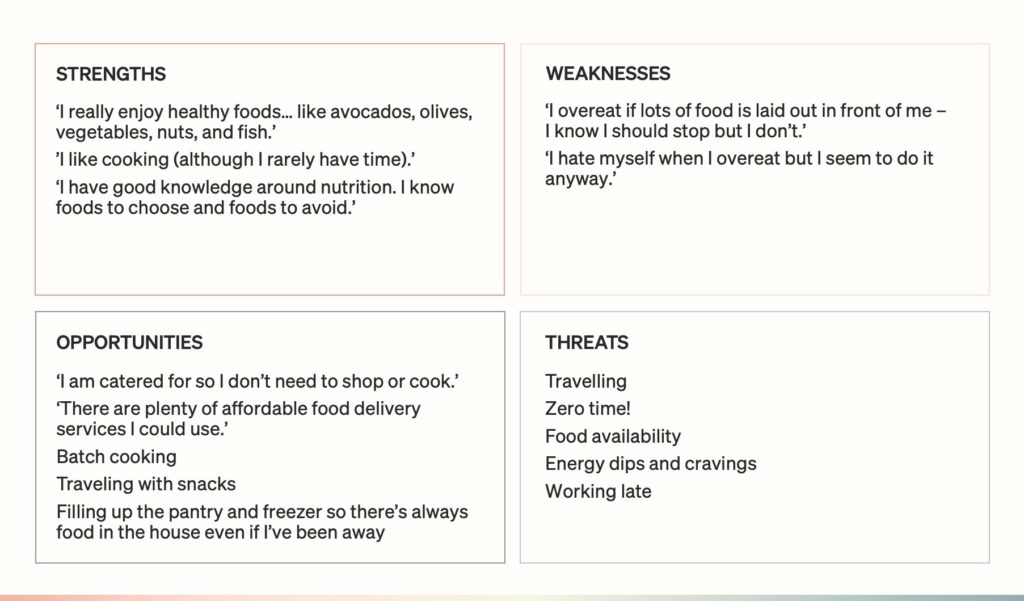A 4-Point Plan to Create Your Personal Nutrition Philosophy

Changing your eating habits is no easy feat. Try this 4-point plan to find an optimal diet that looks like you.
Studies show that an optimal diet can increase life expectancy by 10 years. Ten extra years is a huge gain. If you’d offer a business a financial opportunity of this magnitude you’d have an action plan whipped up in no time. I invite you to sketch a personalised nutrition template for your life, which I’ll guide you through in under 7 minutes, peppered by real customer examples.
What’s a Personal Nutrition Philosophy?
Your own personal Nutrition Philosophy serves as a guide for your nutrition decisions. It’s your ‘nutrition compass’. It makes nutrition decisions effortless: keeping you on track when you are time-poor and helping you preserve brain capacity for whatever life throws at you. As one client said:
“Having my own nutrition philosophy equates to freedom for me. I feel totally liberated from the food rules of various diets I have been on in the past. I now just do ‘me’.”
The Hintsa approach to a Personal Nutrition Philosophy
Whether working with a World Champion, a country leader, or a business executive, at Hintsa we aim to understand the unique needs of the person in front of us. You won’t find anyone of us touting the latest diet trend. We ask a lot of questions, find out what you need, and apply the relevant scientific evidence. We can use hundreds of biomarkers to fine tune individuals for peak performance. But a biochemical snapshot is not enough. We ask our clients to connect deeply with themselves. How do they feel, physically and mentally? What are their nutritional strengths and blind spots?
How can you do this yourself? What follows is a 4-point plan to craft your Personal Nutrition Philosophy.
1. Assess your personal strengths and weaknesses, strategically
Businesses do SWOT analyses, and it’s actually not a bad framework to start from. Run your personal nutrition SWOT analysis to help you identify where your biggest challenges are. Here are some client examples:

After completing your SWOT analysis, you first want to plan to mitigate your weaknesses and threats, for example:
A global executive decided to not buy multi-packs of processed snack foods – the ones she tends to overeat (these are crafted to be hyperpalatable and addictive). Although she would occasionally still buy them in singles, now she has no more multi-packs in the house.
A UK-based consultant bought a large box of mixed nuts in mini-packets – being pre-packaged in a travel size meant he could just grab and go for his commute. This is now a habit when he leaves the house: coffee, pack of nuts, and an apple.
Second, you’ll want to capitalise on any strengths and opportunities. For example, a professional athlete had absolutely no time to cook in the week but he enjoys cooking for dinner parties (‘glory-chefing’, according to his wife). He now makes extra when he cooks and portions it up for another day. He batch cooks one Sunday per month. And he cooks a tray of roasted vegetables while the oven is on, stacking it in the fridge for a quick salad, paired with meat or fish, or for a soup.
What does your SWOT analysis look like? What practical ideas does it generate for you?
2. What are your values around food and nutrition?
Have you ever considered this? Most people haven’t, but it’s been a game-changer for many.
Ask yourself three simple questions:
- What does eating mean to me?
- What do I want to achieve from eating?
- Do my eating habits reflect me as a person?
Reflect on this client example:
“I want to nourish my body. By nature, I’m a giver: I give to work, I give to my family, and by choosing healthy foods I give back to me. Previously I ate to comfort myself, to reward myself for hard work, for being busy. My food choices were addictive, usually sugar or caffeine. They gave me the fix I craved but they also made me tired, which probably made life harder! I now eat to nourish, I listen to what my body wants, and I have a lot more energy.”
Undernourishment is more common than we think. Many are unaware that they are overfed, but paradoxically undernourished. Research shows that younger adults, who should be in the nutritional prime of their lives, are particularly vulnerable to micronutrient shortfalls. Undernourishment can result from a mismatch between food values and eating habits.
“I was so detached from what food is. Considering my food values made me realise what I want: I want to eat whole foods, in their most natural form. I now think about the journey the produce has been on, I feel thankful for the food I eat, and I avoid wasting food. My desire to eat junk food vanished, I don’t respect it or value it as a food source anymore.”
“Food is about sharing and joy to me. I want to enjoy good food while connecting with others. So I’m making more time to eat away from my desk, with colleagues.”
Ask yourself: how aligned are your eating habits to your food values?
3. When am I going to eat?
‘Chrononutrition’ is a fancy word to describe when we eat. You only have to look at animals and infants to realise that a feeding rhythm is important, and indeed a schedule for eating is beneficial for health.
It’s up to you to choose your schedule but try these guidelines:
- Don’t graze all day. Plan a routine which includes 2-3 meals a day, and mini-fasts between meals of 2-4 hours. This gives your digestive system a break and allows you to be metabolically flexible (being able to use both fat and carbohydrates as a fuel source).
- ‘Freeze the fridge’ at night. Keep a daytime eating rhythm – eating at night impairs glycaemic response (leading to blood sugar highs and lows and overeating). Eating within an 8 to 12 hour eating window has many health benefits. If you eat outside of that – keep it high protein, low carb, and small.
- Don’t leave it to chance. Leaving food decisions to chance, particularly when travelling or stressed, means making poor choices. Eating out is associated with an average of 200 extra calories, and eating out twice a week can translate to an extra 6lb of weight gain a year.
- Be specific. At what time will you have breakfast? And what time will you ‘freeze the fridge’ in the evening?
“I used to eat whenever I had a spare moment, essentially grazing throughout the day. I had terrible bloating that would come on after midday. Afternoon meetings were a nightmare! I tried removing different foods, but I just couldn’t work out the problem. I can’t believe how following an eating schedule and properly chewing my food resolved my gut problems. I’d had these issues for years, I’d seen the doctor, and the solution was so simple! It still happens occasionally but I feel so much more in control now I know how to get back on track.”
4. Tune into your hunger cues
In a world of “on-demand food” it’s easy to become detached from your hunger cues. Ask yourself: Are you hungry? And I mean: do you experience physical hunger?
There are two types of hunger. One is physical hunger: that’s your stomach rumbling and your body needing nourishment or energy. The other is ‘mind-hungry’ – this happens when we’re stressed, bored, seeking comfort, or plugging an emotional need.
As you might guess, it’s the physical hunger we should follow. When was the last time you felt this? We don’t want raging and uncontrollable hunger, but learning to be comfortable with modest hunger is a signal you’re eating the right amount for you. If you’re not hungry by your next meal you might have overeaten at the previous or not allowed a long enough gap. Creating a personalised food schedule will make this easier.
“It took me a while to experience physical hunger. Unbelievably, it was an alien feeling. I have a proper rhythm now. I’ve got to grips with how much to eat to feel hunger again by the next meal. The main difference is energy – I don’t get huge crashes or sleepiness anymore.”
This guide to your personalised nutrition philosophy is meant to help you tune into your unique needs and create your own blueprint to guide your decisions. If you can get clear on these 4 points, the rest comes easy. Eating in alignment with your values, physical needs, and practical realities makes the process more enjoyable, and healthy decisions come with more ease. And remember – don’t aim for 100% perfection, 80% is more than enough.



